Further reading
- Jon Latimer, Burma: The Forgotten War, London: John Murray, 2004 ISBN 0-7195-6576-6
During the Second World War, Operation Capital, Operation Y, was a broad British offensive launched on 19 November 1944 from Assam, India across the Chindwin River into northeast Burma near Mandalay. The objectives were to clear Japanese forces from northern Burma, reopen the Burma Road supply route to China and tie down Japanese forces to prevent their transfer to the Pacific theatre. The British Fourteenth Army struck the Japanese Fifteenth Army near Imphal and Kohima. The Japanese were forced to pull back to a line from Indaw to Mandalay, vacating most of Burma.
During planning, the operation was renamed Extended Capital to include a pursuit of the enemy to Rangoon.
See Battle of Meiktila and Mandalay for a fuller description of this operation and its context.
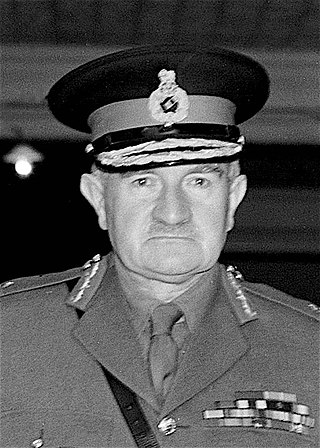
Field Marshal William Joseph Slim, 1st Viscount Slim,, usually known as Bill Slim, was a British military commander and the 13th Governor-General of Australia.

The British Fourteenth Army was a multi-national force comprising units from Commonwealth countries during the Second World War. As well as British Army units, many of its units were from the Indian Army and there were also significant contributions from British Army's West and East African divisions. It was often referred to as the "Forgotten Army" because its operations in the Burma Campaign were overlooked by the contemporary press, and remained more obscure than those of the corresponding formations in Europe for long after the war. For most of the Army's existence, it was commanded by Lieutenant-General William Slim.

The Burma campaign was a series of battles fought in the British colony of Burma. It was part of the South-East Asian theatre of World War II and primarily involved forces of the Allies against the invading forces of the Empire of Japan. Imperial Japan was supported by the Thai Phayap Army, as well as two collaborationist independence movements and armies. The first of these was the Burma Independence Army, which spearheaded the initial attacks against the country. The Indian National Army, led by Subhas C. Bose of the Free India movement, also collaborated with Imperial Japan, especially during Operation U-Go in 1944. Nominally independent puppet states were established in the conquered areas and some territories were annexed by Thailand. In 1942 and 1943, the international Allied force in British India launched several failed offensives to retake lost territories. Fighting intensified in 1944, and British Empire forces peaked at around 1,000,000 land and air forces. These forces were drawn primarily from British India, with British Army forces, 100,000 East and West African colonial troops, and smaller numbers of land and air forces from several other Dominions and Colonies. These additional forces allowed the Allied recapture of Burma in 1945.

The South-East Asian Theatre of World War II consisted of the campaigns of the Pacific War in the Philippines, Thailand, Indonesia, Indochina, Burma, India, Malaya and Singapore between 1941 to 1945.
The 10th Princess Mary's Own Gurkha Rifles,, was originally a rifle regiment of the British Indian Army. The regiment was formed in 1890, taking its lineage from a police unit and over the course of its existence it had a number of changes in designation and composition. It took part in a number of campaigns on the Indian frontiers during the 19th and early 20th centuries, before fighting in the First World War, the Third Anglo-Afghan War and the Second World War. Following India's independence in 1947, the regiment was one of four Gurkha regiments to be transferred to the British Army. In the 1960s it was active in the Malayan Emergency and Indonesian Confrontation. It was amalgamated with the other three British Gurkha regiments to form the Royal Gurkha Rifles in 1994.
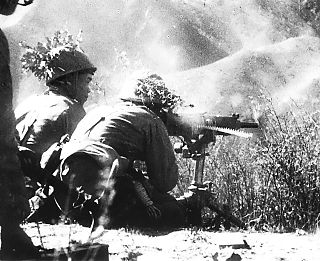
The Japanese Burma Area Army was a field army of the Imperial Japanese Army during World War II.

The concurrent Battle of Meiktila and Battle of Mandalay were decisive engagements near the end of the Burma campaign during World War II. Collectively, they are sometimes referred to as the Battle of Central Burma. Despite logistical difficulties, the Allies were able to deploy large armoured and mechanised forces in Central Burma, and also possessed air supremacy. Most of the Japanese forces in Burma were destroyed during the battles, allowing the Allies to later recapture the capital, Rangoon, and reoccupy most of the country with little organised opposition.
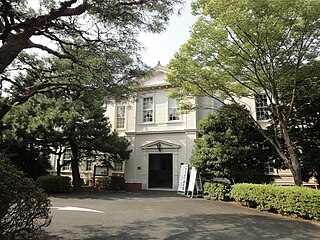
The 15th Division was an infantry division in the Imperial Japanese Army. Its tsūshōgō code name was the Festival Division, and its military symbol was 15D. The 15th Division was one of four new infantry divisions raised by the Imperial Japanese Army in the closing stages of the Russo-Japanese War (1904–1905). With Japan's limited resources towards the end of that conflict, the entire IJA was committed to combat in Manchuria, leaving not a single division to guard the Japanese home islands from attack. The 15th Division was initially raised from men in the area surrounding Nagoya under the command of Lieutenant General Okihara Kofu.

The Battle of Pakokku and Irrawaddy River operations were a series of battles fought between the British Indian Army and the Imperial Japanese Army and allied forces over the successful Allied Burma campaign on the China Burma India Theater during World War II. The battles and operations were instrumental in facilitating the eventual capture of Rangoon in summer 1945.
The Japanese occupation of Burma was the period between 1942 and 1945 during World War II, when Burma was occupied by the Empire of Japan. The Japanese had assisted formation of the Burma Independence Army, and trained the Thirty Comrades, who were the founders of the modern Armed Forces (Tatmadaw). The Burmese hoped to gain support of the Japanese in expelling the British, so that Burma could become independent.
The Battles and Operations involving the Indian National Army during World War II were all fought in the South-East Asian theatre. These range from the earliest deployments of the INA's preceding units in espionage during Malayan Campaign in 1942, through the more substantial commitments during the Japanese Ha Go and U Go offensives in the Upper Burma and Manipur region, to the defensive battles during the Allied Burma campaign. The INA's brother unit in Europe, the Indische Legion did not see any substantial deployment although some were engaged in Atlantic wall duties, special operations in Persia and Afghanistan, and later a small deployment in Italy. The INA was not considered a significant military threat. However, it was deemed a significant strategic threat especially to the Indian Army, with Wavell describing it as a target of prime importance.

The Japanese 15th Army was an army of the Imperial Japanese Army during World War II. It was involved in the invasion of Burma in December 1941 and served in that country for most of its war service.
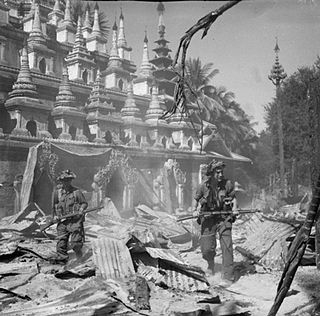
The Burma campaign in the South-East Asian Theatre of World War II was fought primarily by British Commonwealth, Chinese and United States forces against the forces of Imperial Japan, who were assisted to some degree by Thailand, the Burmese National Army and the Indian National Army. The British Commonwealth land forces were drawn primarily from the United Kingdom, British India and Africa.

The Third Anglo-Burmese War, also known as the Third Burma War, took place during 7–29 November 1885, with sporadic resistance continuing into 1887. It was the final of three wars fought in the 19th century between the Burmese and the British. The war saw the loss of sovereignty of an independent Burma under the Konbaung dynasty, whose rule had already been reduced to the territory known as Upper Burma, the region of Lower Burma having been annexed by the British in 1853, as a result of the Second Anglo-Burmese War.
The British Indian XXXIII Corps was a corps-sized formation of the Indian Army during the Second World War. It was disbanded and the headquarters was recreated as an Army headquarters in 1945.
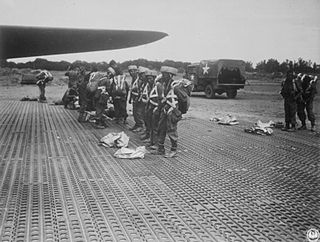
The Battle of Elephant Point was an airborne operation at the mouth of the Yangon River conducted by a composite Gurkha airborne battalion that took place on 1 May 1945. In March 1945, plans were made for an assault on Rangoon, the capital of Burma, as a stepping-stone on the way to recapturing Malaya and Singapore. Initial plans for the assault on the city had called for a purely land-based approach by British Fourteenth Army, but concerns about heavy Japanese resistance led to this being modified with the addition of a joint amphibious-airborne assault. This assault, led by 26th Indian Division, would sail up the Rangoon River, but before it could do so, the river would have to be cleared of Japanese and British mines. In order to achieve this, coastal defences along the river would have to be neutralized, including a battery at Elephant Point.
No. 273 Squadron RAF was a Royal Air Force squadron formed as reconnaissance unit in World War I, and re-formed in World War II in Ceylon - initially as a torpedo bomber and reconnaissance unit. In mid 1944 the squadron was re-equipped with Spitfire Mk VIIIs and flew and fought out of airfields in India and Burma. Following the end of the war, the squadron was moved first to Siam (Thailand), and then later, French Indo-China (Vietnam). It was re-equipped with Spitfire Mk XIVs in November 1945.
Y Force was the South East Asia Command designation given to Chinese National Revolutionary Army forces that re-entered Burma from Yunnan in 1944 as one of the Allies fighting in Burma Campaign of World War II. It consisted of 175,000 troops divided into 15 divisions.

The Battle of the Sittang Bend and the Japanese Breakout across Pegu Yomas were linked Japanese military operations during the Burma Campaign, which took place nearly at the end of World War II. Surviving elements of the Imperial Japanese Army who had been driven into the Pegu Yoma attempted to break out eastwards in order to join other Japanese troops retreating from the British forces. The break-out was the objective of the Japanese Twenty-Eighth Army with support at first from the Thirty-Third Army and later the Fifteenth Army. As a preliminary, the Japanese Thirty-Third Army attacked Allied positions in the Sittang Bend, near the mouth of the river, to distract the Allies. The British had been alerted to the break-out attempt and it ended calamitously for the Japanese, who suffered many losses, with some formations being wiped out.

Saharat Thai Doem was an administrative division of Thailand. It encompassed parts of the Shan States of British Burma annexed by the Thai government after the Japanese conquest of Burma.